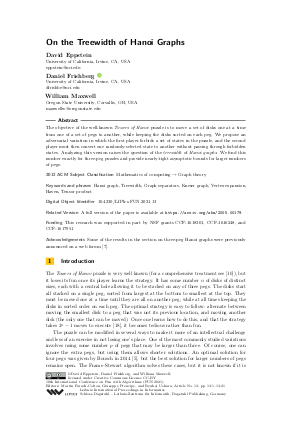On the Treewidth of Hanoi Graphs
Authors
David Eppstein,
Daniel Frishberg  ,
William Maxwell
,
William Maxwell
-
Part of:
Volume:
10th International Conference on Fun with Algorithms (FUN 2021)
Part of: Series: Leibniz International Proceedings in Informatics (LIPIcs)
Part of: Conference: International Conference on Fun with Algorithms (FUN) - License:
 Creative Commons Attribution 3.0 Unported license
Creative Commons Attribution 3.0 Unported license
- Publication Date: 2020-09-16
File

PDF
LIPIcs.FUN.2021.13.pdf
- Filesize: 0.6 MB
- 21 pages
Document Identifiers
Related Versions
-
A full version of the paper is available at https://arxiv.org/abs/2005.00179.
Subject Classification
ACM Subject Classification
- Mathematics of computing → Graph theory
Keywords
- Hanoi graph
- Treewidth
- Graph separators
- Kneser graph
- Vertex expansion
- Haven
- Tensor product
Metrics
- Access Statistics
-
Total Accesses (updated on a weekly basis)
0Document
0Metadata
Abstract
The objective of the well-known Towers of Hanoi puzzle is to move a set of disks one at a time from one of a set of pegs to another, while keeping the disks sorted on each peg. We propose an adversarial variation in which the first player forbids a set of states in the puzzle, and the second player must then convert one randomly-selected state to another without passing through forbidden states. Analyzing this version raises the question of the treewidth of Hanoi graphs. We find this number exactly for three-peg puzzles and provide nearly-tight asymptotic bounds for larger numbers of pegs.
Cite As Get BibTex
David Eppstein, Daniel Frishberg, and William Maxwell. On the Treewidth of Hanoi Graphs. In 10th International Conference on Fun with Algorithms (FUN 2021). Leibniz International Proceedings in Informatics (LIPIcs), Volume 157, pp. 13:1-13:21, Schloss Dagstuhl – Leibniz-Zentrum für Informatik (2020)
https://doi.org/10.4230/LIPIcs.FUN.2021.13
BibTex
@InProceedings{eppstein_et_al:LIPIcs.FUN.2021.13,
author = {Eppstein, David and Frishberg, Daniel and Maxwell, William},
title = {{On the Treewidth of Hanoi Graphs}},
booktitle = {10th International Conference on Fun with Algorithms (FUN 2021)},
pages = {13:1--13:21},
series = {Leibniz International Proceedings in Informatics (LIPIcs)},
ISBN = {978-3-95977-145-0},
ISSN = {1868-8969},
year = {2020},
volume = {157},
editor = {Farach-Colton, Martin and Prencipe, Giuseppe and Uehara, Ryuhei},
publisher = {Schloss Dagstuhl -- Leibniz-Zentrum f{\"u}r Informatik},
address = {Dagstuhl, Germany},
URL = {https://drops.dagstuhl.de/entities/document/10.4230/LIPIcs.FUN.2021.13},
URN = {urn:nbn:de:0030-drops-127741},
doi = {10.4230/LIPIcs.FUN.2021.13},
annote = {Keywords: Hanoi graph, Treewidth, Graph separators, Kneser graph, Vertex expansion, Haven, Tensor product}
}
Author Details
Funding
This research was supported in part by NSF grants CCF-1618301, CCF-1616248, and CCF-1617951.
Acknowledgements
Some of the results in the section on three-peg Hanoi graphs were previously announced on a web forum [Eppstein, 2016].
References
- Danielle Arett and Suzanne Dorée. Coloring and counting on the tower of Hanoi graphs. Mathematics Magazine, 83(3):200-209, 2010. URL: https://doi.org/10.4169/002557010x494841.
- Stefan Arnborg, Andrzej Proskurowski, and Derek G. Corneil. Forbidden minors characterization of partial 3-trees. Discrete Mathematics, 80(1):1-19, 1990. URL: https://doi.org/10.1016/0012-365X(90)90292-P.
- László Babai and Mario Szegedy. Local expansion of symmetrical graphs. Combinatorics, Probability and Computing, 1(1):1–11, 1992. URL: https://doi.org/10.1017/S0963548300000031.
- Hans L. Bodlaender. Fixed-parameter tractability of treewidth and pathwidth. In Hans L. Bodlaender, Rod Downey, Fedor V. Fomin, and Dániel Marx, editors, The Multivariate Algorithmic Revolution and Beyond: Essays Dedicated to Michael R. Fellows on the Occasion of His 60th Birthday, volume 7370 of Lecture Notes in Computer Science, pages 196-227. Springer, 2012. URL: https://doi.org/10.1007/978-3-642-30891-8_12.
- Thierry Bousch. La quatrième tour de Hanoï. Bulletin of the Belgian Mathematical Society - Simon Stevin, 21(5):895-912, 2014. URL: http://projecteuclid.org/euclid.bbms/1420071861.
- Boštjan Brešar and Simon Špacapan. On the connectivity of the direct product of graphs. The Australasian Journal of Combinatorics, 41:45-56, 2008. URL: https://ajc.maths.uq.edu.au/pdf/41/ajc_v41_p045.pdf.
- David Eppstein. Treewidth of deep Sierpiński sieve graph. Theoretical Computer Science Stack Exchange. URL: https://cstheory.stackexchange.com/q/36542.
- David Eppstein and Elham Havvaei. Parameterized leaf power recognition via embedding into graph products. In Christophe Paul and Michal Pilipczuk, editors, 13th International Symposium on Parameterized and Exact Computation (IPEC 2018), volume 115 of Leibniz International Proceedings in Informatics (LIPIcs), pages 16:1-16:14, Dagstuhl, Germany, 2019. Schloss Dagstuhl-Leibniz-Zentrum fuer Informatik. URL: https://doi.org/10.4230/LIPIcs.IPEC.2018.16.
- Jeff Erickson. Computational topology: Treewidth. Lecture Notes, 2009. URL: http://jeffe.cs.illinois.edu/teaching/comptop/2009/notes/treewidth.pdf.
-
Andreas M. Hinz et al. The Tower of Hanoi emdash Myths and Maths. Birkhäuser Basel, 2013.

- Peter Frankl. A new short proof for the Kruskal-Katona theorem. Discrete Mathematics, 48(2-3):327-329, 1984. URL: https://doi.org/10.1016/0012-365X(84)90193-6.
- Daniel J. Harvey and David R. Wood. Treewidth of the Kneser Graph and the Erdős-Ko-Rado theorem. Electronic Journal of Combinatorics, 21(1):P1.48, 2014. URL: https://doi.org/10.37236/3971.
-
Wilfried Imrich, Sandi Klavžar, and Douglas F. Rall. Topics in Graph Theory: Graphs and Their Cartesian Product. A K Peters, 2008.

-
Kyohei Kozawa, Yota Otachi, and Koichi Yamazaki. Lower bounds for treewidth of product graphs. Discrete Applied Mathematics, 162(C):251–258, January 2014.

- L. Lovász. Kneser’s conjecture, chromatic number, and homotopy. Journal of Combinatorial Theory, Series A, 25(3):319-324, 1978. URL: https://doi.org/10.1016/0097-3165(78)90022-5.
-
L. Lovász. Combinatorial Problems and Exercises. AMS/Chelsea publication. North-Holland Publishing Company, 1993.

- J. Nešetřil and P. Ossona de Mendez. Sparsity: Graphs, Structures, and Algorithms, volume 28 of Algorithms and Combinatorics. Springer, 2012. URL: https://doi.org/10.1007/978-3-642-27875-4.
-
Miodrag S. Petković. Famous Puzzles of Great Mathematicians. American Mathematical Society, 2009.

- Paul D. Seymour and Robin Thomas. Graph searching and a min-max theorem for tree-width. Journal of Combinatorial Theory, Series B, 58(1):22-33, 1993. URL: https://doi.org/10.1006/jctb.1993.1027.
- B. M. Stewart and J. S. Frame. Problem 3918 and solution. The American Mathematical Monthly, 48(3):216-219, 1941. URL: https://doi.org/10.2307/2304268.
- Mario Valencia-Pabon and Juan-Carlos Vera. On the diameter of Kneser graphs. Discrete Mathematics, 305(1-3):383-385, 2005. URL: https://doi.org/10.1016/j.disc.2005.10.001.
